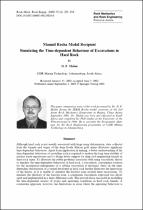JavaScript is disabled for your browser. Some features of this site may not work without it.
- ResearchSpace
- →
- Research Publications/Outputs
- →
- Journal Articles
- →
- View Item
| dc.contributor.author |
Malan, DF

|
en_US |
| dc.date.accessioned | 2007-02-06T12:20:00Z | en_US |
| dc.date.accessioned | 2007-06-07T10:04:41Z | |
| dc.date.available | 2007-02-06T12:20:00Z | en_US |
| dc.date.available | 2007-06-07T10:04:41Z | |
| dc.date.copyright | en_US | |
| dc.date.issued | 2002-10 | en_US |
| dc.identifier.citation | Malan, DF. 2002. Simulating the time-dependent behaviour of excavations in hard rock. Rock Mechanics and Rock Engineering, vol. 35(4), pp 225-254 | en_US |
| dc.identifier.issn | 0723-2632 | en_US |
| dc.identifier.uri | http://hdl.handle.net/10204/1533 | en_US |
| dc.identifier.uri | http://hdl.handle.net/10204/1533 | |
| dc.description.abstract | Although hard rock is not usually associated with large creep deformation, data collected from the tunnels and stopes of the deep South African gold mines illustrates significant time-dependent behaviour. Apart from application in mining, a better understanding of the time-dependent behaviour of crystalline rock is required to analyse the long term stability of nuclear waste repositories and to design better support for deep civil engineering tunnels in these rock types. To illustrate the subtle problems associated with using viscoelastic theory to simulate the time-dependent behaviour of hard rock, a viscoelastic convergence solution for the incremental enlargement of a tabular excavation is discussed. Data on the time dependent deformation of a tunnel developed in hard rock further illustrates the limitations of the theory, as it is unable to simulate the fracture zone around these excavations. To simulate the rheology of the fracture zone, a continuum viscoplastic approach was developed and implemented in a finite deference code. This proved more successful in modelling the time-dependent closure of stopes and squeezing conditions in hard rock tunnels. A continuum approach, however, has limitations in areas where the squeezing behaviour is dominated by the time-dependent behaviour of prominent discontinuities such as bedding planes. To overcome this problem, a viscoplastic displacement discontinuity technique was developed. This, combined with a tessellation approach, leads to more realistic modelling of the time-dependent behaviour of the fracture zone around excavations. | en_US |
| dc.format.extent | 701508 bytes | en_US |
| dc.format.mimetype | application/pdf | en_US |
| dc.language.iso | en | en_US |
| dc.publisher | Springer-Verlag | en_US |
| dc.rights | Copyright: 2002 Springer-Verlag | en_US |
| dc.source | en_US | |
| dc.subject | Nuclear waste repositories | en_US |
| dc.subject | Tabular excavation | en_US |
| dc.subject | Fracture zone rheology | en_US |
| dc.subject | Tunnel deformation | en_US |
| dc.subject | Stopes | en_US |
| dc.subject | Viscoelastic theory | en_US |
| dc.subject | Continuum elasto-viscoplastic modelling | en_US |
| dc.subject | Discontinuum elasto-viscoelastic modelling | en_US |
| dc.subject | Numerical simulation | en_US |
| dc.subject | Engineering | en_US |
| dc.subject | Geosciences | en_US |
| dc.title | Simulating the time-dependent behaviour of excavations in hard rock | en_US |
| dc.type | Article | en_US |
| dc.identifier.apacitation | Malan, D. (2002). Simulating the time-dependent behaviour of excavations in hard rock. http://hdl.handle.net/10204/1533 | en_ZA |
| dc.identifier.chicagocitation | Malan, DF "Simulating the time-dependent behaviour of excavations in hard rock." (2002) http://hdl.handle.net/10204/1533 | en_ZA |
| dc.identifier.vancouvercitation | Malan D. Simulating the time-dependent behaviour of excavations in hard rock. 2002; http://hdl.handle.net/10204/1533. | en_ZA |
| dc.identifier.ris | TY - Article AU - Malan, DF AB - Although hard rock is not usually associated with large creep deformation, data collected from the tunnels and stopes of the deep South African gold mines illustrates significant time-dependent behaviour. Apart from application in mining, a better understanding of the time-dependent behaviour of crystalline rock is required to analyse the long term stability of nuclear waste repositories and to design better support for deep civil engineering tunnels in these rock types. To illustrate the subtle problems associated with using viscoelastic theory to simulate the time-dependent behaviour of hard rock, a viscoelastic convergence solution for the incremental enlargement of a tabular excavation is discussed. Data on the time dependent deformation of a tunnel developed in hard rock further illustrates the limitations of the theory, as it is unable to simulate the fracture zone around these excavations. To simulate the rheology of the fracture zone, a continuum viscoplastic approach was developed and implemented in a finite deference code. This proved more successful in modelling the time-dependent closure of stopes and squeezing conditions in hard rock tunnels. A continuum approach, however, has limitations in areas where the squeezing behaviour is dominated by the time-dependent behaviour of prominent discontinuities such as bedding planes. To overcome this problem, a viscoplastic displacement discontinuity technique was developed. This, combined with a tessellation approach, leads to more realistic modelling of the time-dependent behaviour of the fracture zone around excavations. DA - 2002-10 DB - ResearchSpace DP - CSIR KW - Nuclear waste repositories KW - Tabular excavation KW - Fracture zone rheology KW - Tunnel deformation KW - Stopes KW - Viscoelastic theory KW - Continuum elasto-viscoplastic modelling KW - Discontinuum elasto-viscoelastic modelling KW - Numerical simulation KW - Engineering KW - Geosciences LK - https://researchspace.csir.co.za PY - 2002 SM - 0723-2632 T1 - Simulating the time-dependent behaviour of excavations in hard rock TI - Simulating the time-dependent behaviour of excavations in hard rock UR - http://hdl.handle.net/10204/1533 ER - | en_ZA |






